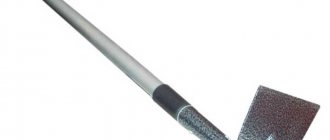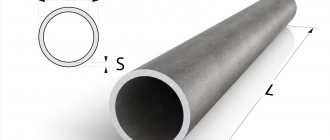When carrying out heating, plumbing or sewer repairs in a house, you often need to know the diameter of the pipe. For example, when replacing a section of a pipe line for any purpose, cutting into it a pipe of a different size, and even more so from a different material, is problematic and sometimes impossible, but not every owner knows how to measure the diameter of a pipe.
It will not be possible to do without measuring instruments, since the approximate result will not suit anyone. You can use a ruler-circometer or laser measuring instruments, but this output is most likely intended for professional activities, and how to determine the size of the pipe circumference if the measurement is one-time? For this, improvised devices are used.
Self-measurement of pipe diameter
Pipe diameters external and internal
Before you find out how the diameter of a pipe is calculated, you need to determine what diameter you need to calculate. All pipe products that are used for gas and water supply, as well as for sewage disposal, are classified by internal diameter. This indicator is also called conditional passage, since the throughput of the entire system depends on it. The inner diameter is designated Dу, the outer diameter is Dн, and the wall thickness is h. Such designations allow you to conveniently carry out calculations and design a wide variety of pipelines for residential and commercial premises.
With the same outer diameter, the inner diameter can vary depending on the wall thickness. The last indicator is selected based on the required mechanical strength of the product. For more precise standardization, GOST 355–52 was introduced, which regulates the nominal flow rate of pipe products. Each subsequent standard nominal diameter provides approximately 50% greater pipe capacity than the previous one.
Nominal or nominal diameter is a term that is often used instead of the concept of nominal bore. Often the internal diameter of the pipe and its nominal bore are different. The difference can be from 1 to 10 mm. The conditional or nominal diameter is the main characteristic of the product. It is this parameter that is decisive for the design and installation of any type of pipeline.
The diameters of pipes for water and gas are usually calculated in inches. Due to the fact that the metric measurement system is widespread in the post-Soviet space, difficulties often arise with the correct calculation of the width of pipes. Such situations arise when connecting pipelines made of different materials. To avoid mistakes, you should use special tables that are created specifically for quick and accurate calculation of sizes. Next, we will learn how to measure the diameter of a pipe using available tools.
Types of steel pipes
The diameters of steel pipes are important, but not the only criterion. The manufacturing method plays a major role in the possibility of further exploitation. There are several types:
- Straight-seam . To make electric-welded pipes, you have to use sheet steel. The essence of production is simple: the material is bent to the required diameter, after which the structure is fixed in this form. Conventional welding is used to connect the edges. Thanks to this, the seam width is reduced to a minimum. To control the quality of manufactured products, the manufacturer checks the compliance of the characteristics with the regulated standards established in the relevant sections: GOST 10704-91, GOST 10705-80 GOST 10706-76.
- Pipe compliance with 10706-26 is an excellent indicator and can tell a lot about the product. As practice shows, this is one of the most profitable offers on the market, if you rely on the price/quality criterion. Such pipes are double reinforced inside and outside, so they can boast a long service life. The size ranges from 10 to 1420 millimeters.
- When using steel in coils, spiral-welded pipes are obtained. Their seam is much larger than their predecessors, which negatively affects the characteristics. For example, such a pipe will cope much worse with high internal pressure.
- Seamless representatives are justifiably considered the best. The process of their manufacture is much more complicated, but can be done even without the use of high temperatures. Due to the absence of a seam, the pressure is distributed evenly and there are no weak points.
The seam is the most vulnerable spot Source svarkaed.ru
To understand which type is best to purchase, you need to decide on the tasks. If the load exerted is small, a spiral suture option is also suitable. If the system has to cope with really difficult tasks, it is better to give preference to a seamless analogue. There is no point in saving, as they say: “The miser pays twice.” It’s better to do everything right away with high quality than to make numerous modifications later.
See also: Catalog of projects of houses with a garage
How to calculate the diameter of a pipe in the simplest ways?
In the house you often have to do a variety of jobs that only real men should handle. No one is immune from breakdowns in the sewerage, water supply, and heating systems. As you know, the bulk of work in these areas is related to pipes, so you should almost always have a special tool on hand to measure their diameter with the subsequent possibility of carrying out high-quality repairs or installation.
How to find out the diameter of a pipe at home? As measuring devices, you can use a ruler, a regular tape measure or a caliper. The procedure can be performed in many ways, each of them has its own nuances and is used in certain conditions. If there is direct access to the pipe, then you won’t have to invent anything. To measure the width, you need to take a ruler and apply it to the cut of the product.
Try to place the ruler exactly in the middle of the section so that the diameter value is as accurate as possible.
Types of parameters and measurements
The theory behind the question is that the size of a circle is not always displayed in centimeters, and the measurement system may not be linear (metric), but inch. One inch is 2.54 cm. But that’s not all: any pipe size has an external and internal parameter value, and you can find out these values at home, most often only by measuring the part.
The internal parameter Dinternal is a mathematical reflection of the throughput load of the pipe opening. For working with pipes in terms of installation or repair of the route, the value of the external Dout will be more important, since in comparison with this parameter the thread and type of threaded connection are selected when connecting products. Different materials mean different wall thicknesses of the product, and therefore different circumference values, the parameters of which will need to be determined separately in each specific case.
Different measurement standards
Commonly available methods that allow you to measure the Ø of pipes at home are:
- Vernier calipers (before, any self-respecting owner had such a tool);
- A flexible synthetic ruler, a sewing tape measure or a soft tape measure.
In addition to the tool, you need to know the value of π - it is equal to 3.1415, and have any calculator at hand. The listed tools measure not only the Ø of plumbing, water, gas or waste pipelines, but also the diameters of any other cylindrical products and assemblies: architectural columns, smooth reinforcement rods, pilasters, etc. To use a tape measure or a soft synthetic ruler, only one measurement is necessary - measure the total length of the circle being measured, for which a tape measure is wrapped around the product, and the result obtained on the scale of the device is divided by the number π. This will be the Ø of the element, expressed in centimeters.
Nominal diameters
How is the diameter of a pipe determined if it is installed?
There are cases when the pipeline is “connected” at both ends, so it will not be possible to use the above method. In this situation, a measuring tape and the slightest mathematical skills will come in handy. Wrap the tape tightly around the pipe and determine its circumference. The resulting number must be divided by the constant “Pi” (3.14) . As a result, we obtain the value of the outer (external) diameter. This method is well suited for measuring large pipes.
How to calculate the internal diameter of a pipe if only the external diameter is known? First you need to determine the wall thickness, then double this value and subtract it from the outer diameter.
In order to find out the thickness of the pipe walls, you can use a special table. It shows average wall thicknesses depending on the purpose of the product, the material from which it is made, and its internal diameter.
What are the diameters (+ table with sizes)
It is important to navigate not only the types of pipes, but also the types of diameter. If you use the wrong data for calculation, the entire system may fail. To avoid common mistakes, it is important to familiarize yourself with all the rules and concepts.
It is extremely unprofessional to use exclusively the theoretical pipe diameter for calculations. Yes, it is convenient, fast, but unreliable. To understand how to measure the diameter, you need to decide which parameter needs to be determined. There are several values required for correct calculations:
- Conditional pass. This is the wall-to-wall size of the pipe, measured in millimeters. When using an inch measuring system, rounding is necessary, which may adversely affect the accuracy of the results. The concept is necessary when connecting several elements, for example, a pipe and a fitting.
- The thickness of the walls plays an important role in the accuracy of the calculations. Thanks to the concept, you can easily determine the strength and reliability of the system, calculate the maximum loads and determine the suitability of the pipe for a particular application.
- Outer diameter is the inner diameter to which the wall thickness is added.
- The nominal diameter is an analogue of the nominal diameter, calculated using more accurate methods.
Pipe diameter measurement
It is important to determine in which unit of measurement the result should be. This can be either inches or millimeters. It is much more convenient to use the metric system. This approach makes it possible to more accurately determine the final characteristics of the resulting system. Despite this, inches are most often used. Thanks to them, the result can be easily rounded, which simplifies the task, but reduces the accuracy of the indicators. It is worth noting that the difference is completely insignificant. For a clearer understanding, it is recommended to familiarize yourself with the pipe sizes in inches and millimeters. The table will allow you to easily adapt and learn to understand unfamiliar sizes. Steel pipe diameter table:
| Nominal diameter | Inches |
| 150 | 6 |
| 200 | 8 |
| 250 | 10 |
| 300 | 12 |
| 350 | 14 |
| 400 | 16 |
| 500 | 20 |
The steel pipe diameter sizing chart is designed to allow capacity to increase by up to 50 percent as the index increases. In general, 1 inch is 25.4 millimeters. For example, 86.36 millimeters is a pipe size of 3.4 inches. The diameter of the pipe is 1-2 inches - 25.4 - 50.8 millimeters.
You can often read that in this situation a medium size is perfect. Sometimes it is not entirely clear which size is large and which is small. The first step is to determine what diameter is indicated in the recommendations. When it comes to external diameters, you should rely on the following parameters:
- less than 102 – small ;
- 102 – 246 – average;
- 425 and more are large .
The inner diameter is often not very different from the outer diameter; this does not mean that its measurement can be neglected.
Calculation of the internal diameter of the pipe
To determine the internal dimensions, you need to know the external data. To do this, take a tape measure and circle it around the pipe. Afterwards, the resulting number should be multiplied by 3.1415 (number P).
To determine the internal diameter, you need to know the wall thickness. This value must be multiplied by 2, and then subtract the result from the outer diameter.
Before purchasing pipes, it is necessary to determine the tasks that the installed system will perform. If high resistance to internal pressure is required, it is best to use a seamless option. If the loads are minimal, the choice increases significantly; the seam can be either small or huge. This is a weak point that may not withstand serious stress. When relying on data obtained over time, it is better not to use the cheapest options.
The diameter of the pipes also plays a big role in further operation. To measure, you should use a simple formula: length multiplied by the number P. If we are talking about the internal diameter, it is enough to subtract the wall thickness multiplied by 2 from the results obtained.
Before purchasing a pipe, it is important to determine specific tasks. If this is a small or irregular load, budget options are suitable. Otherwise, only seamless models are needed. Thanks to its reliable structure, such a pipe will not need repairs for as long as possible.
How to calculate the diameter of a pipe using a camera and a box of matches?
How to find out the internal diameter of a pipe if all of the above methods are not suitable? For example, when there is no direct access to half of the pipe or it is impossible to measure the circumference for some reason. In this case, the copying method is used, which is based on comparing the dimensions of the pipe and the control object. The parameters of the latter must be known (an ordinary matchbox, credit card or other item with standard dimensions will work well).
Next, using a camera, we take a picture of the section of the pipeline with the box. We transfer the photo to the computer, since all subsequent calculations will be carried out on it. Using a ruler, you need to measure the matchbox and the thickness of the pipe in the photo (in millimeters). Knowing the dimensions of the box, you can quickly calculate the scale of the photo. Then we translate the width of the product measured in the photo in accordance with the scale and get its outer diameter.
Differences between measurement systems
Sometimes specialists or ordinary users have to deal with the designation of pipe diameters in inches. To convert to metric form, inches to centimeters are converted using the formula 1 to 2.54 cm.
Usually there is no need to carry out such calculations on a calculator; there are special tables to simplify the task. However, when using them, you should know that the values of inches in millimeters are different for different types of pipes. If we consider metal pipes, then the ratio of 25.4 mm to 1 inch is maintained almost at this level without large errors and indicates the width of their passage channel.
If polymer pipes are measured in inches, this means an outer diameter that is one larger than the internal diameter for metal or polymer products themselves.
There is also a pipe inch, which regulates the dimensional characteristics of products with pipe threads; its value per unit is 33.25 mm.
Rice. 10 Conversion table inches to mm
Defectiveness of products - how to calculate the diameter of a pipe without errors?
When installing a sewer, water or gas pipeline, it is worth considering that all pipes have a permissible deviation standard. Parameters such as length, outer diameter and wall thickness may not be accurate. All permissible deviations are regulated by GOST and, if necessary, manufacturers must provide certificates and documents. We will not dwell in detail on how to select the diameter of the pipe, taking into account all kinds of defects. We note only deviations from the norm permitted by GOST.
All pipe products at large construction sites undergo mandatory control procedures. Certificates are verified and must contain a number of parameters, such as chemical analysis of the material and test results. The presence of markings on the pipes is also monitored, which should indicate the main characteristics, date of manufacture and manufacturer. Often the marking is applied to the surface of one of the ends of the product.
For pipes used in residential construction (with a diameter of less than 200 mm), the maximum deviation can be 1.5 mm.
The permissible deviations in the diameters of large pipes are approximately 0.7%, and accurate measurements are carried out using special ultrasonic installations. The length of the product is the indicator that can deviate from the norm more than any other. According to GOST, pipe products of the second accuracy class may have a deviation of ± 100 mm. The permissible standard for first class pipes is ± 15 mm. The wall thickness may also differ from the declared one: deviations can be up to ± 5%.
In addition, there is such a defect as the curvature of the product: its permissible value is no more than 0.15% of the length. For example, for a pipe 1 m long, the permissible deviation is 1.5 mm. For pipes with an oval cross-section, dimensional inaccuracies are also acceptable. According to GOST, the permissible deviation of the ovality parameter should not exceed 1% of that declared by the manufacturer. To check this deviation, you need to know how the diameter of a pipe with an oval cross-section is measured: it is the arithmetic mean between the largest and smallest section width. The ovality index itself can be determined as follows:
- measure the largest and smallest section width;
- subtract the difference between them;
- divide the resulting value by the nominal diameter;
To accurately determine the ovality parameter, a special device is used - a bore gauge.
How to measure an angle with a tape measure
A tape measure can be used to check the right angle of the walls. As you know, walls should be perpendicular to each other, and the angle between them should be 90 degrees at any height.
To check for distortion, do the following:
- Measure two arbitrary distances from the center of the corner. For example, 1.5 on one wall and 2 m on the other.
- Place pencil marks at the same height.
- Make calculations: square the length of each segment and add the resulting values. Take the square root of the resulting sum. Example: (1.5×1.5)+(2×2)=6.25. √ 6.25=2.5.
- We get the distance in m (cm) between two segments at an angle of 90 degrees. In the proposed version, the figure will be 2.5 m.
You can make it even simpler and use the table:
You can use a tape measure to measure not only the angle between walls, but also between the wall and the floor, furniture parts, etc. If you divide the values by 100, we get the length of the diagonal in millimeters (for checking the angle in small parts).
To measure an angle of 45 degrees, divide the value in half. Example: 141.4 ÷ 2 = 70.7 cm diagonal between 100 cm segments. To get an angle of 30 degrees, divide the value by 3, etc.
How many mm are 3 4 inches?
Inch pipe 3/4 inch: Pipe diameter 3/4 inch (nominal diameter): 20 (mm); 3/4 inch pipe dimensions (outer diameter): 26.8 (mm);
Interesting materials:
What can you see on Tsvetnoy Boulevard? What can you see in Gelendzhik in winter? What can you put behind the door? What can you hang on the window from the sun? What can you wish for at the competition? What can you make from cornstarch? What can be made from wool? What can you bring to OGE in geography? What can you take to improve your memory? What can you take if you have allergies?











